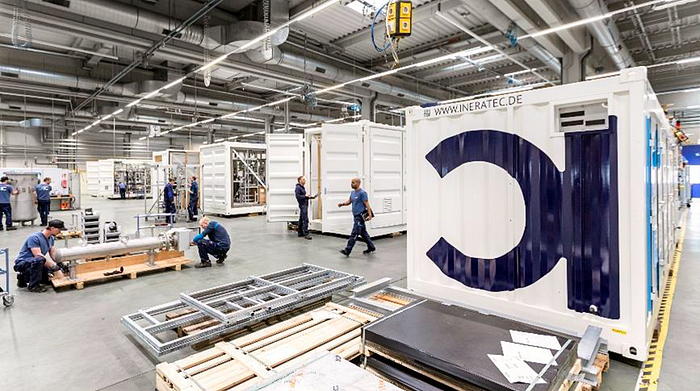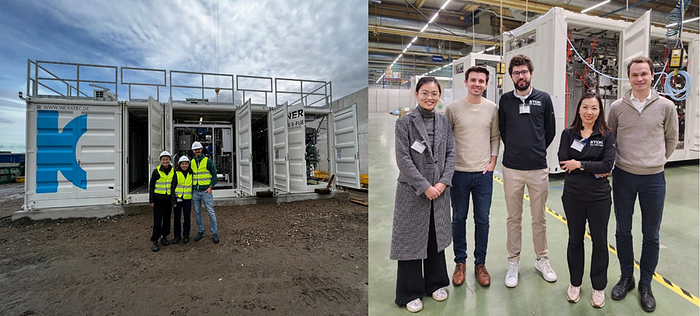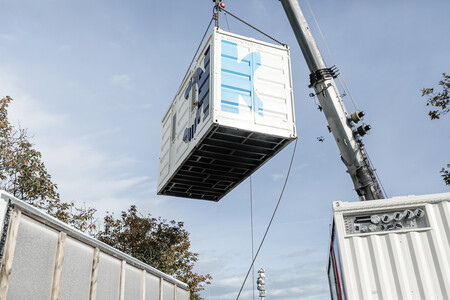INTRODUCTION
If you’ve been following our investment strategy and engagements at TDK Ventures, you are probably already aware of our passion for companies and technologies driving towards a more sustainable future. We strive to be impact scalers for those incredible entrepreneurs ushering in the next generation of energy transformation (EX). Over the past few years, we’ve taken several deep dives into these landscapes to understand what industrial and global needs are, what solutions could/should exist, and what entrepreneurial visions have the potential to deliver those needs. This kind of learning is never really finished, but if anything has become clear, it is that the solution to a sustainable tomorrow is not one path, but many.
The transportation sector contributes roughly 16% of global greenhouse gas annually. While most of those emissions come from road transportation, the aviation and maritime sectors contribute 2.5% [1] and 2.8% [2] of global greenhouse gas, respectively. Without mitigation, both sectors’ emissions are expected to grow and double by 2040.
A SOLUTION FOR NOW
Aviation and maritime are hard-to-abate transportation sectors. There are several technology options for decarbonization, namely battery electrification, hydrogen, and low-carbon liquid fuel, such as sustainable aviation fuel (SAF). However, because most aviation and maritime transportation involves long distances, low-carbon liquid fuels offer a combination of significant carbon reduction with the simultaneous propensity for rapid integration and adoption. Unlike other alternatives, such as battery-electric or hydrogen airplanes that may require significant infrastructure changes and technological advancements, SAF can be integrated into existing engine systems, would not interfere with current operations, and could leverage existing refueling infrastructure. This allows for the significant gains represented by massive carbon emission reduction to be available for use today.
TABLE 1. Comparison of energy sources and various implications on integration into aviation operations and systems [3].

WHAT IS SAF?
SAF is liquid hydrocarbon fuels generated from biogenic or waste feedstock. It is a ready-to-use fuel, but instead of leveraging fossil fuels and petroleum processing, leveraging green sources and, therefore, naturally reducing subsequent carbon emissions by anywhere between 30–60%.
Producing SAF involves a process that converts these low-carbon feedstocks into liquid fuels compatible with existing aviation engines. The feedstocks can be broadly categorized under the umbrella of biofuel or e-fuel. The latter uses carbon dioxide (CO2) and green H2 as feedstock. These feedstocks are typically converted to intermediate products, such as syngas (CO and H2), ethanol, or methanol. Subsequently, there are a few different conversion processes to convert the intermediates to liquid fuels. The most common of which are:
- Fischer-Tropsch (FT) Synthesis: This process converts synthesis gas (syngas) to long-chain hydrocarbons with the use of a catalyst [4]. There are several approaches to make syngas, including gasification of biomass or solid waste, or by converting CO2 to syngas through a reverse-water-gas-shift (RWGS) process.
- Alcohol-to-Jet (ATJ) Synthesis: This pathway involves converting alcohols like ethanol or butanol into jet fuel. The alcohols are dehydrated to form alkenes, which are then oligomerized (joined together) to form longer hydrocarbon chains typical of jet fuel [5].
- Methanol-to-Jet (MTJ) Synthesis: This pathway starts from methanol, which can be derived from CO2 electrolysis or a chemical catalyst reaction of syngas. Then, methanol is converted to SAF via the methanol-to-jet technology, which involves the methanol-to-olefins and olefins oligomerization process.
- Direct hydrogenation: New catalysts are being developed to enable direct hydrogenation of CO2 to liquid fuels.

WHY SAF NOW?
Three strong drivers converge and put an urgency on the commercialization of low-carbon fuels.
· Strong Regulatory Push:
The European Union has passed the ReFuelEU aviation initiative to mandate all aviation fuel suppliers to ensure that all aviation fuel made available to aircraft operators contains a minimum share of SAF which is starting at 2% in 2025 and increasing gradually to 6% in 2030, and 70% in 2050 [6]. This excludes the fuel production from food and feed crops. The Directive also specifies the minimum amount of ‘synthetic aviation fuels’ that is renewable fuel of non-biological origin (RFNBO), such as e-fuels, starting at 0.7% in 2030 and increasing annually to 35% by 2050.
Similarly, the FuelEU maritime initiative aims to gradually reduce the greenhouse gas intensity of maritime fuel starting at 2% in 2025 and reaching a 75% reduction by 2050.
Furthermore, the Treasury Department under the Biden-Harris administration has recently announced the SAF tax credit of $1.25-$1.75 per gallon for SAF which achieves at least 50% greenhouse gas emission reduction compared with regular jet fuel [7].
· Strong Demand Pull:
Several airlines and maritime operators have entered into offtake agreements for SAF and low-carbon marine fuels to decarbonize their fleets. They, in turn, generate carbon credits, which can be sold to corporations who are interested in offsetting their scope 3 emissions coming from the business travels.
· Shortage of Supply:
The European Union Aviation Safety Agency (EASA) estimated that the maximum potential SAF production capacity in the EU is currently around 300 million liters, or only 10% of the required volume to meet the mandate by 2030. This represents an opportunity for early-mover startups to enter the market and take advantage of the price premium offered by several off-take partners.
CATCH-22: THE VALLEY OF DEATH AND A MASSIVE GRAVEYARD OF BIOFUEL 1.0
Despite the market being red hot for SAF and low-carbon marine fuel, scaling a large first-of-a-kind (FOAK) biofuel facility is not without a challenge. In the past, several large-scale advanced cellulosic ethanol projects ran into operational problems and eventually ended up shutting down. These include the $225m Iowa project that once belonged to DuPont, or the $275m Project Liberty — a JV between POET and DSM, as well as a $300M Oregon plant developed by a VC-backed Red Rock Biofuels that never completed the construction.
What can we learn from the story of biofuel 1.0? It is perhaps the fact that a one-shot built approach to constructing the FOAK facility with a very high capital investment is extremely risky. There are always a lot of unknowns when scaling up. Chemical processes of the past have always been scaled up this way by increasing the reactor size to make it bigger to increase production and lower the fixed cost. Then when there is an upset in the process, the whole production grinds to a halt. In a venture-backed company, this also means that cash burn continues while such halts are being investigated for failure analysis and future reengineering.
What if the chemical processes can be scaled modularly like how battery manufacturing or solar PV production are scaled? And what if modular reactors do not cost more than building conventional reactors, and instead they provide more load flexibility and operational reliability? Could this be the winning solution to a renewable oil field of the future?
INERATEC: LEADING THE CHARGE
INERATEC, a spin-out from Karlsruhe Institute of Technology (KIT) in Germany, has distinguished itself as an innovator as it works to commercialize its patented modular microstructured reactor to produce SAF — as well as other low-carbon fuels like marine diesel oil, e-gasoline, and e-methanol. After two decades of development at KIT and further refining by the company, INERATEC has built an impressive foundation with a few key characteristics:
- Highest Scalability: INERATEC’s modular reactors can be mass-produced in a gigafactory, providing a necessary throughput for production scaling. The reactors are manufactured using standard high-throughput processes like milling, stamping, stacking, and welding, found in automotive manufacturing. Currently, a 1 MW (~300 gpd/ 350 ton per annum) modular plant can be assembled in just six weeks.
- Best Efficiency: INERATEC’s microstructure reactors offer superior heat transfer, high conversion efficiency, better integration with renewables, and lower production costs. The reactors can facilitate temperature changes within seconds, resulting in over 90% exergetic efficiency, faster reaction rates, and less need for catalysts. (For comparison, traditional Fischer-Tropsch in a conventional reactor provides around 43% energetic efficiency.) In addition, the high heat transfer rate allows for a flexible operation under variable renewable electricity and hydrogen loads of 30–110%. This feature cannot be achieved in a conventional chemical reactor design.
- Strong Strategic Partnerships: INERATEC is not only a top-project developer but also boasts strong strategic partnerships and a robust customer pipeline. Their approach to scaling proven by the track record of over 21 completed and active projects and over 28,000 hours of cumulative production, positions them as a leader in the e-fuel industry.
Their reactor systems have been delivered to many customers using a variety of feedstocks, including CO2 and gasified biomass, as well as customers who make other products from CO2, such as e-methanol, and specialty e-waxes. The micro structured reactors are catalyst agnostics, and the company will continue to partner with the best catalyst companies in the world to accelerate the commercialization timeline.

By adopting INERATEC solutions, the aviation and shipping industry could witness a monumental and rapid shift towards sustainability. The sector’s carbon footprint could quickly diminish, contributing to global efforts to combat climate change and pushing the industry closer to its carbon neutrality objectives. Today, the company is scaling up its first e-fuel facility in Frankfurt, converting biogenic CO2 from landfills into liquid fuels. In the near future, they plan to expand globally leveraging partnerships they have secured in many geographies.
The INERATEC approach of rapidly commercializing turnkey solutions to aid decarbonization directly supports longer-term developments in energy transformation and provides a critical transition pathway as such innovations begin to mature. In essence, INERATEC’s success could be a pivotal moment in global sustainability efforts, demonstrating the feasibility and benefits of a transition to greener, more sustainable energy solutions across various industries.
WHY WE INVESTED
TDK Ventures invested in INERATEC because of the alignment between their strategic vision and our investment thesis:
- Attractive and Sustainable Future: INERATEC’s pioneering approach to producing sustainable aviation fuel (SAF) and other low-carbon fuels addresses critical challenges in decarbonizing the hard-to-abate aviation and shipping industries, a sector significantly contributing to global CO2 emissions. The ability of INERATEC’s modular reactor technology to efficiently produce SAF from biogenic or waste feedstock offers a practical and immediate solution for reducing carbon emissions, resonating with TDK Ventures’ contributing to society mission.
- Venture-style Financial Return: INERATEC demonstrates the King-of-the-Hill prowess through its exceptional scalable technology and project execution acumen. The modular nature of their reactors allows for mass production in a Gigafactory, providing a clear path to de-risk technology as production scales increase. This capability, coupled with their first-mover advantage, best-in-class heat transfer, high conversion efficiency, and ability to operate with variable renewable energy sources, positions INERATEC as a market leader in the e-fuel field and a valuable investment in this $300B fuel industry.
- Strategic Value with Synergies: There is a natural strategic fit between INERATEC’s technology and TDK Ventures’ greater portfolio and our Limited Partners’ interests. In essence, the e-fuels industry drives the demand for renewable energy and green hydrogen. By investing in INERATEC, which is developing e-fuel projects around the globe, we can enjoy front-row seats and obtain real-time market insights on the evolving landscape of clean energy and green technologies, which will inform our Limited Partners on the requirements for the next-generation electronic components needed for the oil field of the future. This alignment ensures that TDK can continue to deliver innovative solutions that meet the demands of a rapidly transforming energy sector.

REFERENCES:
[1] Hannah Ritchie (2020) — “Climate change and flying: what share of global CO2 emissions come from aviation?” Published online at OurWorldInData.org. Retrieved from: ‘https://ourworldindata.org/co2-emissions-from-aviation’ [Online Resource]
[2] Review of maritime transport 2023 (2023). United Nations UNCTAD. Retrieved from: Review of Maritime Transport 2023 | UNCTAD
[3] Wollf, C., & Riefer, D. (2020, January). Clean skies for tomorrow: Sustainable aviation fuels as a pathway to net-zero aviation. In Proceedings of the World Economic Forum, Davos-Klosters, Switzerland (pp. 21–24).
[4] Fischer-Tropsch synthesis. (n.d.). Retrieved from https://www.netl.doe.gov/research/carbon-management/energy-systems/gasification/gasifipedia/ftsynthesis
[5] Geleynse, S., Brandt, K., Garcia‐Perez, M., Wolcott, M., & Zhang, X. (2018). The alcohol‐to‐jet conversion pathway for drop‐in biofuels: techno‐economic evaluation. ChemSusChem, 11(21), 3728–3741.
[6] Regulation of the European Parliament and the council on ensuring a level playing field for sustainable air transport (ReFuelEU Aviation). (2023) Retrieved from: pdf (europa.eu)
[7] Retrieved from: U.S. Department of the Treasury, IRS Release Guidance to Drive American Innovation, Cut Aviation Sector Emissions | U.S. Department of the Treasury. (2023 December)
